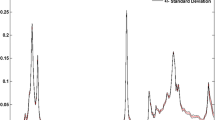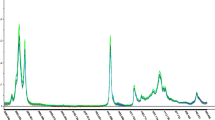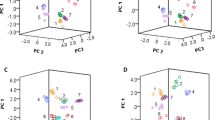Abstract
The identification of the authenticity of edible vegetable oils is important from both consumer health and commercial aspect. Fourier transform infrared spectroscopy combined with multivariate statistical analysis methods was used to identify the authenticity of olive oils. Partial least squares discriminant analysis (PLS-DA) based on a reduced subset of variables was employed to build classification models. For the purpose of variable selection, a modified Monte Carlo uninformative variable elimination (MC-UVE) technique was proposed. Comparing with other variable selection techniques, PLS-DA model using the selected variables by the modified MC-UVE provided better results. The classification accuracy obtained by cross validation was 97.6 %, and the correct classification rate of the prediction set was 100 %. The results show that the model based on the modified MC-UVE is successful in the inspection of the authenticity of olive oils.


Similar content being viewed by others
References
Araújo MCU, Saldanha TCB, Galvão RKH, Yoneyama T, Chame HC, Visani V (2001) The successive projections algorithm for variable selection in spectroscopic multicomponent analysis. Chemometr Intell Lab 57:65–73
Ballabio D, Consonni V, Mauri A, Todeschini R (2010) Canonical Measure of Correlation (CMC) and Canonical Measure of Distance (CMD) between sets of data. Part 3. Variable selection in classification. Anal Chim Acta 657:116–22
Boschetti CE, Olivieri AC (2004) A new genetic algorithm applied to the near infrared analysis of gasolines. J Near Infrared Spec 12:85–91
Cai W, Li Y, Shao X (2008) A variable selection method based on uninformative variable elimination for multivariate calibration of near-infrared spectra. Chemometr Intell Lab 90:188–94
Centner V, Massart DL (1996) Elimination of uninformative variables for multivariate calibration. Anal Chem 68:3851–8
Chong IG, Jun CH (2005) Performance of some variable selection methods when multicollinearity is present. Chemometr Intell Lab 78:103–12
Devos O, Downey G, Duponchel L (2014) Simultaneous data pre-processing and SVM classification model selection based on a parallel genetic algorithm applied to spectroscopic data of olive oils. Food Chem 148:124–30
Fang G, Goh JY, Tay M, Lau HF, Li SFY (2013) Characterization of oils and fats by 1H NMR and GC/MS fingerprinting: classification, prediction and detection of adulteration. Food Chem 138:1461–9
Goicoechea HC, Olivieri AC (2003) A new family of genetic algorithms for wavelength interval selection in multivariate analytical spectroscopy. J Chemometr 17:338–45
Han Q, Wu H, Cai C, Xu L, Yu R (2008) An ensemble of Monte Carlo uninformative variable elimination for wavelength selection. Anal Chim Acta 612:121–5
Jabeur H, Zribi A, Makni J, Rebai A, Abdelhedi R, Bouaziz M (2014) Detection of Chemlali extra-virgin olive oil adulteration mixed with soybean oil, corn oil, and sunflower oil by using GC and HPLC. J Agric Food Chem 62:4893–904
Leardi R, Nørgaard L (2004) Sequential application of backward interval partial least squares and genetic algorithms for the selection of relevant spectral regions. J Chemometr 18:486–97
Lerma-García MJ, Ramis-Ramos G, Herrero-Martínez JM, Simó-Alfonso EF (2010) Authentication of extra virgin olive oils by Fourier-transform infrared spectroscopy. Food Chem 118:78–83
Lerm-García MJ, Ramis-Ramos G, Herrero-Martínez JM, Simó-Alfonso EF (2008) Classification of vegetable oils according to their botanical origin using sterol profiles established by direct infusion mass spectrometry. Rapid Commun Mass Sp 22:973–8
Li H, Liang Y, Xu Q, Cao D (2009) Key wavelengths screening using competitive adaptive reweighted sampling method for multivariate calibration. Anal Chim Acta 648:77–84
Liu T, Zhou Y, Lv J, Chen Z, Li B, Shi Y (2013) Authentication of edible vegetable oil and refined recycled cooking oil using a micro-UV spectrophotometer based on chemometrics. J Am Oil Chem Soc 90:1599–606
Luna AS, da Silva AP, Ferré J, Boqué R (2013) Classification of edible oils and modeling of their physico-chemical properties by chemometric methods using mid-IR spectroscopy. Spectrochim Acta A 100:109–14
Mildner-Szkudlarz S, Jelen HH (2008) The potential of different techniques for volatile compounds analysis coupled with PCA for the detection of the adulteration of olive oil with hazelnut oil. Food Chem 110:751–61
Omidikia N, Kompany-Zareh M (2013) Uninformative variable elimination assisted by Gram–Schmidt orthogonalization/successive projection algorithm for descriptor selection in QSAR. Chemometr Intell Lab 128:56–65
Paiva HM, Soares SFC, Galvão RKH, Araújo MCU (2012) A graphical user interface for variable selection employing the successive projections algorithm. Chemometr Intell Lab 118:260–6
Poulli KI, Mousdis GA, Georgiou CA (2006) Synchronous fluorescence spectroscopy for quantitative determination of virgin olive oil adulteration with sunflower oil. Anal Bioanal Chem 386:1571–5
Rezzi S, Axelson DE, Héberger K, Reniero F, Mariani C, Guillou C (2005) Classification of olive oils using high throughput flow 1H NMR fingerprinting with principal component analysis, linear discriminant analysis and probabilistic neural networks. Anal Chim Acta 552:13–24
Ruiz-Samblás C, Cuadros-Rodríguez L, González-Casado A, de Paula Rodrí-guez García F, de la Mata-Espinosa P, Bosque-Sendra JM (2011) Multivariate analysis of HT/GC-(IT)MS chromatographic profiles of triacylglycerol for classification of olive oil varieties. Anal Bioanal Chem 399:2093–103
Saptoro A, Yao HM, Tadé MO, Vuthaluru HB (2008) Prediction of coal hydrogen content for combustion control in power utility using neural network approach. Chemometr Intell Lab 94:149–59
Tang G, Huang Y, Tian K, Song X, Yan H, Hu J, Xiong Y, Mina S (2014) A new spectral variable selection pattern using competitive adaptive reweighted sampling combined with successive projections algorithm. Analyst 139:4894–902
Torrecilla JS, Rojo E, Domínguez JC, Rodríguez F (2010) Linear and non linear chemometric models to quantify the adulteration of extra virgin olive oil. Talanta 83:404–9
Wang A, Xie L (2014) Technology using near infrared spectroscopic and multivariate analysis to determine the soluble solids content of citrus fruit. J Food Eng 143:17–24
Wu W, Walczak B, Massart DL, Heuerding S, Erni F, Last IR, Prebble KA (1996) Artificial neural networks in classification of NIR spectral data: design of the training set. Chemometr Intell Lab 33:35–46
Yang Y, Ferro MD, Cavaco I, Liang Y (2013) Detection and identification of extra virgin olive oil adulteration by GC-MS combined with chemometrics. J Agric Food Chem 61:3693–702
Ye S, Wang D, Min S (2008) Successive projections algorithm combined with uninformative variable elimination for spectral variable selection. Chemometr Intell Lab 91:194–9
Zhang L, Li P, Sun X, Wang X, Xu B, Wang X, Ma F (2014) Classification and adulteration detection of vegetable oils based on fatty acid profiles. J Agric Food Chem 62:8745–51
Acknowledgments
The work was financially supported by the National natural Science Foundation of China (Grant No. 21575131).
Author information
Authors and Affiliations
Corresponding authors
Ethics declarations
This article does not contain any studies with human participants or animals performed by any of the authors.
Conflict of Interest
All authors declare that they have no conflict of interest.
Informed Consent
Not applicable.
Rights and permissions
About this article
Cite this article
Li, X., Wang, S., Shi, W. et al. Partial Least Squares Discriminant Analysis Model Based on Variable Selection Applied to Identify the Adulterated Olive Oil. Food Anal. Methods 9, 1713–1718 (2016). https://doi.org/10.1007/s12161-015-0355-8
Received:
Accepted:
Published:
Issue Date:
DOI: https://doi.org/10.1007/s12161-015-0355-8




